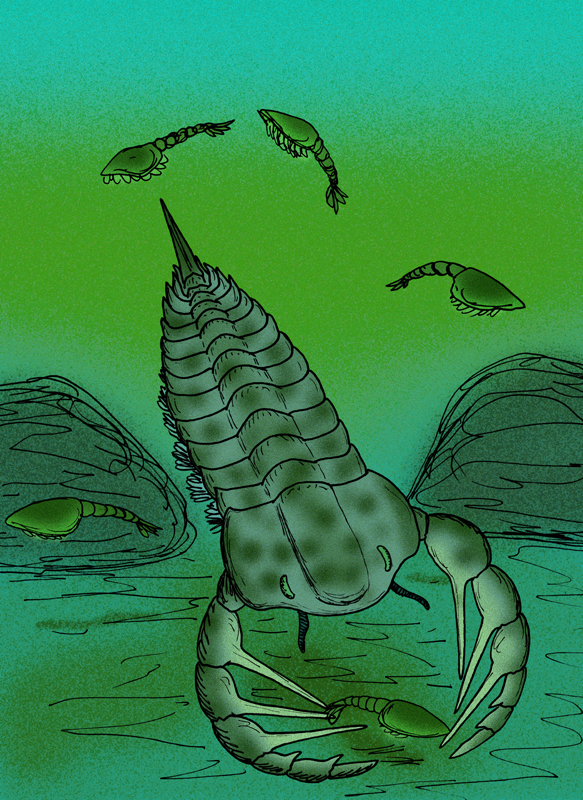Kodymirus on:
[Wikipedia]
[Google]
[Amazon]
''Kodymirus'' is a genus of Early
 ''Kodymirus'' inhabited the Paseky Shale, within the modern day Czech Republic, which may be a shallow marine environment or brackish
''Kodymirus'' inhabited the Paseky Shale, within the modern day Czech Republic, which may be a shallow marine environment or brackish
Cambrian
The Cambrian ( ) is the first geological period of the Paleozoic Era, and the Phanerozoic Eon. The Cambrian lasted 51.95 million years from the end of the preceding Ediacaran period 538.8 Ma (million years ago) to the beginning of the Ordov ...
arthropod
Arthropods ( ) are invertebrates in the phylum Arthropoda. They possess an arthropod exoskeleton, exoskeleton with a cuticle made of chitin, often Mineralization (biology), mineralised with calcium carbonate, a body with differentiated (Metam ...
, known from the Czech Republic
The Czech Republic, also known as Czechia, and historically known as Bohemia, is a landlocked country in Central Europe. The country is bordered by Austria to the south, Germany to the west, Poland to the northeast, and Slovakia to the south ...
. Although it possessed great appendage
Megacheira ("great hands", also historically great appendage arthropods) is an extinct class of predatory arthropods defined by their possession of spined "great appendages". Their taxonomic position is controversial, with studies either consider ...
-like raptorial arms, it was not homologous with those of megacheirans. ''Kodymirus'' is currently considered a member of Vicissicaudata
Vicissicaudata is an unranked group of artiopodan arthropods, containing Cheloniellida, Aglaspidida and several other genera outside these groups like ''Sidneyia'' and ''Emeraldella.''
Description
Vicissicaudatans are similar to most other ...
, closely related to aglaspidids, and more distantly to trilobites
Trilobites (; meaning "three-lobed entities") are extinct marine arthropods that form the class Trilobita. One of the earliest groups of arthropods to appear in the fossil record, trilobites were among the most successful of all early animals, ...
. It is part of a small and low-diversity Paseky Shale fauna group, which dwelt in brackish waters.
Description
''Kodymirus'' was a small predator at long. Its distinctive feature is pair of large, serratedraptorial
In biology (specifically the anatomy of arthropods), the term ''raptorial'' implies much the same as ''predatory'' but most often refers to modifications of an arthropod leg, arthropod's foreleg that make it function for the grasping of prey whi ...
appendages. These appendages appear convergent to those of megacheirans and radiodonts
Radiodonta is an extinct order of stem-group arthropods that was successful worldwide during the Cambrian period. Radiodonts are distinguished by their distinctive frontal appendages, which are morphologically diverse and were used for a variety ...
, but are not homologous as they postantennular, suggesting raptorial arms evolved multiple times in Cambrian arthropods.
Paleoecology
 ''Kodymirus'' inhabited the Paseky Shale, within the modern day Czech Republic, which may be a shallow marine environment or brackish
''Kodymirus'' inhabited the Paseky Shale, within the modern day Czech Republic, which may be a shallow marine environment or brackish estuary
An estuary is a partially enclosed coastal body of brackish water with one or more rivers or streams flowing into it, and with a free connection to the open sea. Estuaries form a transition zone between river environments and maritime enviro ...
. Trace fossils from the Shale have been interpreted as ''Kodymirus'' raking its claws along the sediment while swimming, disturbing benthic prey buried beneath the muck. This would make ''Kodymirus'' the earliest known arthropod predator in the intertidal zone
The intertidal zone or foreshore is the area above water level at low tide and underwater at high tide; in other words, it is the part of the littoral zone within the tidal range. This area can include several types of habitats with various ...
.
Taxonomy
''Kodymirus'' was previously considered an enigmatic arthropod, and its precise taxonomic affinity remained uncertain. It was initially believed to be an earlyeurypterid
Eurypterids, often informally called sea scorpions, are a group of extinct marine arthropods that form the Order (biology), order Eurypterida. The earliest known eurypterids date to the Darriwilian stage of the Ordovician period, 467.3 Myr, mil ...
and later a megacheiran. ''Kodymirus'' is currently been placed within the clade Vicissicaudata
Vicissicaudata is an unranked group of artiopodan arthropods, containing Cheloniellida, Aglaspidida and several other genera outside these groups like ''Sidneyia'' and ''Emeraldella.''
Description
Vicissicaudatans are similar to most other ...
, a subgroup of Artiopoda
Artiopoda is a clade of extinct arthropods that includes trilobites and their close relatives. It was erected by Hou and Bergström in 1997 to encompass a wide diversity of arthropods that would traditionally have been assigned to the Trilobitomor ...
, the clade containing trilobites
Trilobites (; meaning "three-lobed entities") are extinct marine arthropods that form the class Trilobita. One of the earliest groups of arthropods to appear in the fossil record, trilobites were among the most successful of all early animals, ...
and their close relatives. Within Vicissicaudata, it is generally considered closely related to the order Aglaspidida
Aglaspidida is an extinct order of marine arthropods known from fossils spanning the Middle Cambrian to the Upper Ordovician. Initially considered chelicerates, modern anatomical comparisons demonstrate that the aglaspidids cannot be accommodated ...
. Its basipods closely resembles those of the vicissicaudatan ''Emeraldella
''Emeraldella'' is a genus of arthropod known from the Middle Cambrian of North America. The type species ''E. brocki'' was described in 1912 from the Burgess Shale. 21 specimens of ''Emeraldella'' are known from the Greater Phyllopod bed, where th ...
.''
Cladogram after McCoy et al. 2025:
References
{{Taxonbar, from=Q1778244 Artiopoda Fossils of the Czech Republic Cambrian genus extinctions